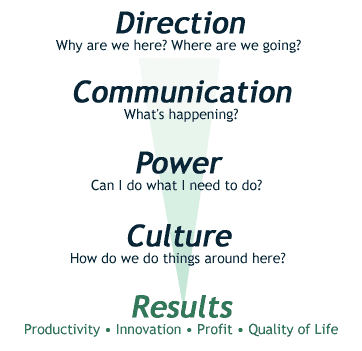The Toolpack Consulting Model
There have been thousands of management and leadership fads over the years. Most of them worked very well when they were first applied, and have tremendous success stories. The early literature for these initiatives - process re-engineering, quality circles, organizational development, team-building, and all the rest - are full of incredible deeds and stories of companies that turned on a dime to achieve amazing things.
The stories are true. Each system worked beautifully.
Each one also failed miserably when applied in other organizations. Each is probably still being applied today, with and without success, in different places. Many are rediscovered each year and assigned different names to be the specialty of a different consulting firm. There's a simple reason for it: each has certain requirements which, if they are filled, will bring success. When those requirements are not met, failure is likely.
We built our individual model by looking at what every other system did, and how they did it. What we found as common ground was:
- Power. Each system pushes power downwards, so people who do the work can make decisions. Some, like job enrichment and empowerment, made this almost the sole focus. Others, such as balanced scorecards and re-engineering, imply it or make it part of the process. Research shows that pushing power downwards in an organization to the lowest possible level greatly increases innovation, motivation, quality, and productivity. It also, paradoxically, increases the power of executives and managers, by freeing them from much of the day-to-day "fire fighting" and trivial decisions, and by providing them with a capable workforce than can carry out their strategic decisions.
- Communication. Again, each system relies on increased communication. It takes many forms, but in essence, communication is spreading information up and down the hierarchy, and across departments; sharing it with customers, suppliers, and partners; and even creating information, as in data mining and market research.
- Direction. Choosing and leading people in a clear direction is the central thrust of leadership initiatives, mission statements, balanced scorecards, and similar systems. People prefer to work with a clear direction in mind; and, when people are aligned, decisions are faster and easier, and there is far less waste.
- Culture. A shared set of values, beliefs, and norms - in short, a shared language and perspective which helps diverse people to work together in harmony. The same people working under different cultures - even in the same organization - can act in very different ways. Change culture, and you change the way people act.
Our model, then, can be seen as a simple rearrangement of the core building blocks:

We designed our systems to make each of these productivity-increasing changes easier.
Each of our products is designed to reach the core issues in the model. Our surveys, for example, are designed to measure the components of the model, and our survey process itself is designed to help organizations in itself, by creating usable information, providing it to people who need it, and, through action planning sessions, providing power and normative cues (opportunities for culture change) to employees throughout the organization.
(Originally developed July 2002)
Copyright © 2001-2024, Toolpack Consulting, LLC. All rights reserved.
